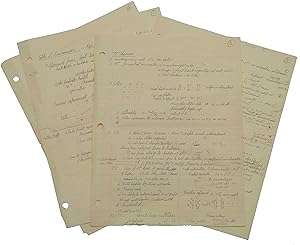About this Item
A detailed draft for a talk given to the Canadian Association of Physics Students, in Vancouver,on the contemporary state of subatomic particle physics, its current difficulties and possible future developments. Although a popular talk, it is pitched at a high level, appropriate to postgraduate students in physics. Feynman manuscripts with scientific content are very rare on the market this is one of a small collection of such manuscripts that was retained by Feynman s family until 2018 when it was consigned to auction. Widely regarded as the most brilliant, influential, and iconoclastic figure in theoretical physics in the post-World War II era, Feynman shared the Nobel Prize in Physics 1965 with Sin-Itiro Tomonaga and Julian Schwinger "for their fundamental work in quantum electrodynamics, with deep-ploughing consequences for the physics of elementary particles." Feynman refers briefly to a talk given to students in Vancouver in Surely You're Joking Mr. Feynman! (p. 343): In Canada they have a big association of physics students. They have meetings; they give papers, and so on. One time the Vancouver chapter wanted to have me come and talk to them. The girl in charge of it arranged with my secretary to fly all the way to Los Angeles without telling me. She just walked into my office. She was really cute, a beautiful blonde. (That helped; it s not supposed to, but it did.) And I was impressed that the students in Vancouver had financed the whole thing. They treated me so nicely in Vancouver that now I know the secret of how to really be entertained and give talks: Wait for the students to ask you. In fact, Feynman gave more than one talk to the Vancouver students, the offered notes probably referring to the second such talk, for in a letter to Mariela Johansen of April 1975, he writes: I often remember vividly my most enjoyable trip. Many things bring it to mind like the dark blue T-shirt in my drawer at home or the interference picture in my office or just now when my secretary asked me if I wanted to talk to students at a nearby university (USC 20 miles) or high school. My answer was that I will talk to students anytime they are near enough to home, or are at Vancouver, B.C. (The Quotable Feynman (2015), p. 296). That these notes probably refer to the second Vancouver talk is confirmed by the first sentence on p. 1, in which Feynman writes: Difference from last time … last year … The slides for this talk, which Feynman refers to at one point in these notes, are preserved in the Feynman archives at Caltech. By 1975, what is now called the Standard Model of particle physics was close to being established. It provides a unified description of three of the four forces through which subatomic particles interact the electromagnetic, weak and strong forces; the fourth force, gravity, has still not been unified with the other three. In this manuscript, Feynman summarizes the current understanding of the Standard Model in 1975, and discusses several significant loose ends . Some of these were resolved in the years following his talk, while others are still open today. The first two of the three forces to be unified were the weak and electromagnetic. In 1957 Julian Schwinger postulated that three different bosons (particles with whole number spin, that obey Bose-Einstein statistics) must be involved in transmitting the weak force to take account of all the possible different ways the nucleons can interact in the nucleus. Two of these bosons were required to exchange positive and negative charges, now called the W+ and W- (weak) bosons; a third neutral boson, the Z0 (which Feynman calls the W0) was required for reactions in which no charge was transferred. In 1973, neutral weak currents (i.e., interactions between particles that involve the exchange of W0 bosons) were observed at CERN, and the electroweak theory became widely accepted. However, the W+, W- and W0 bosons themselves were not observed experiment.
Seller Inventory # 4859
Contact seller
Report this item




